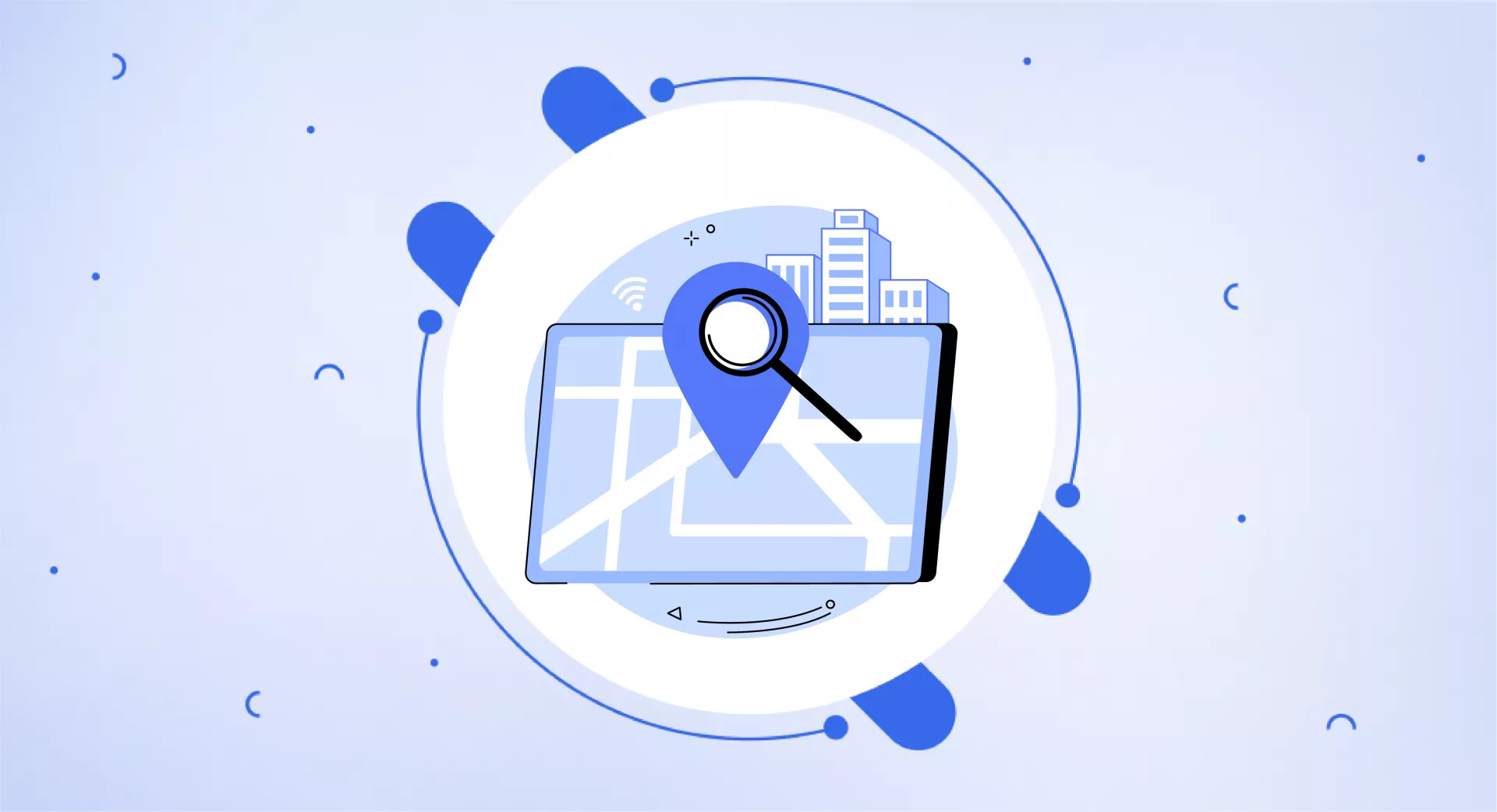Usually, when we need a plumber, it’s urgent. Most of us do not research for hours to find a plumber or look at the local business directories.
People Google it and call the one that appears in the top few results.
So what’s the point? That means your business needs to be here, on the first page of Google to get noticed by your potential customers.
In this guide, you’ll learn all the methods that your business needs to adopt to get a higher ranking.
What is SEO for Plumbers?
SEO, search engine optimization, is a method of optimizing your websites for search engines to improve visibility and get higher rankings.
When we say SEO for plumbers, that means exactly the same thing for plumbing websites.
It involves practices that make those websites easily discoverable by the people searching for them.
Just like other businesses, plumbing websites need to follow on-page, off-page, and technical SEO strategies with a focus on local SEO.
Why is it Important?
SEO matters for every business as you can increase your revenue severalfold. Here are the reasons why it is essential:
Plumbers can increase their online visibility by making their websites SEO-friendly. They may appear for the relevant search terms people use to search for a plumber.
SEO brings an unnoticed plumbing website to the forefront when someone needs it.
It is one of the most cost-effective marketing methods that help you get more qualified leads.
Keep in mind that SEO takes time and requires a lot of patience to see the results. Usually, it takes more than 6 months to get measurable results.
So if you are committed to doing it, nothing will stop you from seeing the improved results and standing out from your competitors.
How to Do SEO for Plumbers?
Basically, you will need to cover two things: one is optimizing your website for Google Business Profile and another one is doing regular SEO efforts to show up in organic search results.
Let’s start with the GBP optimization.
Google Business Profile Optimization
This process helps your website show up in Google Maps as well as organic search results.
You first need to claim your Google Business Profile. It requires you to add all the details relevant to your business.
Make sure that your profile has all the information that a user might be looking for.
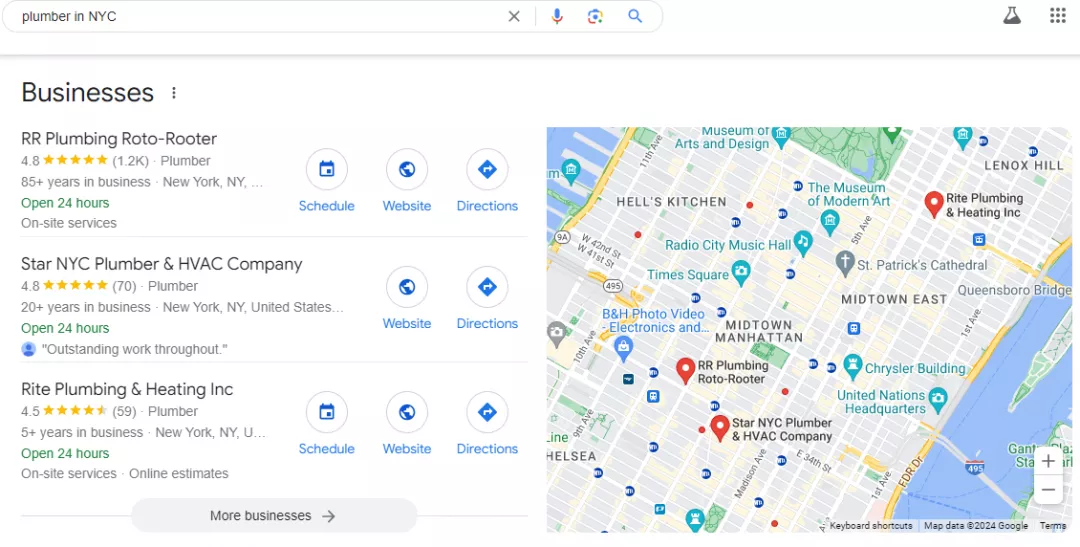
It must have:
Contact information
Opening hours
Opening days
Business Category
Service area
High-quality images
Website
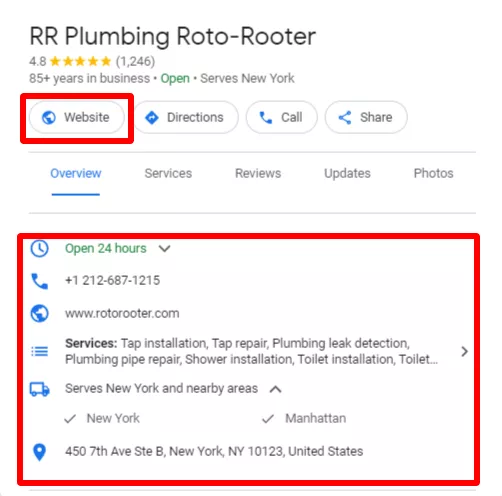
In addition to this, also keep your NAP (name, address, phone number) information accurate and updated.
You probably get most of your traffic from Google but that doesn't mean you should ignore the other search engines.
Besides optimizing and listing your business for Google you must also list it on Bing to improve its visibility in Bing Maps and searches.
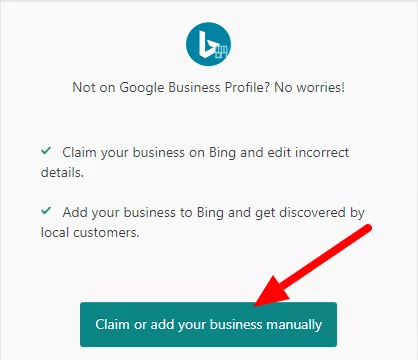
Get listed on local directories or citation sites like Apple Maps, Yelp, and Yellow Pages. These sites allow you to add all the relevant details of your local business/service.
Adding this information will help searchers find your business easily while also allowing search engines to find and display it more effectively in search results.
Quick Tip: You can use tools like ahrefs Link Intersect or Semrush Backlink Gap. They allow you to see all the directories or websites that link to your competitors but not to you. This way you will find plenty of link-building opportunities.
Recommended Reading: Learn how to optimize your GBP in this detailed guide. It is good enough to understand, implement, and increase your chance of showing up in the local map pack.
Keyword Research
Besides GBP, you must also make your website optimized for relevant keywords.
Look for the terms or phrases people are searching for and that are relevant to your services. You will then use those keywords to create the content of your website.
You can use any tool but my recommendation would be to use a paid tool like Semrush or ahrefs. The reason is that their data is more reliable and accurate than many others available in the market.
Check our list of top keyword generators and choose the one that suits your needs and budget.
Now look at how to find keywords for your plumbing website.
First, think about all the potential keywords that a customer may use to find your business. You can take ideas from the services you’ve added to GBP.
See I’ve used the term “drain cleaning services” in the Semrush Keyword Magic tool and it gives me the following results. I clicked the “Related” option and it gave me plenty of ideas.
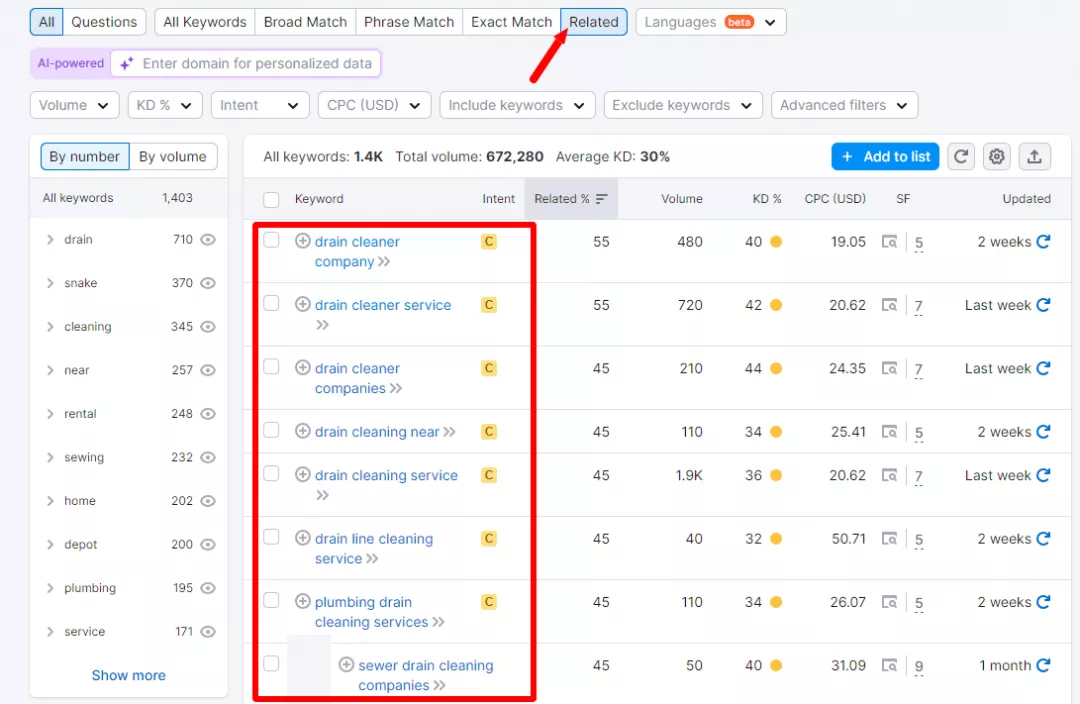
Just remember that for each service you need to create a separate page.
If services are related to one another like “drain line cleaning service” and “drain clearance services”, you can cover both terms on a single page.
This also gives you an idea of how to group relevant keywords. You will choose one focus keyword to write content on.
This main keyword will be supported by adding more relevant keywords that will play a supporting role. Eliminate all those that aren't relevant.
Just to give you an idea, suppose you want to create a page on “drain cleaning services”. This is your main keyword.
You may support your text with additional secondary keywords like this:
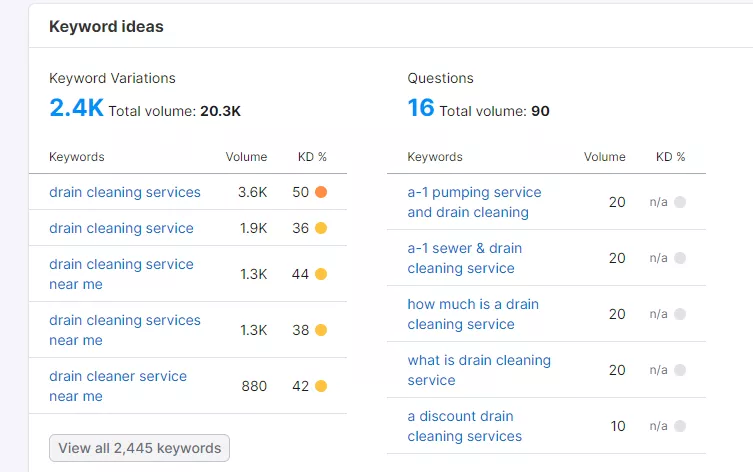
You can pick the maximum keywords that are relevant to your page’s content and discard all those that aren’t and can be covered on separate pages.
Make a separate sheet and add primary keywords along with all secondary, relevant or supporting keywords. This is called keyword grouping. For each group, you will create a separate page or post.
Suggested Reading: There isn’t only one or two ways to find keywords. You can use several methods to ease your keyword hunt journey. I would suggest you read my detailed guide on keyword research to learn about all the best methods to find more keywords.
Content Creation
You have a list of keywords and now you need to create content based on them. There are several pages a plumbing website will focus on for content creation:
Homepage
This is the main page that tells your targeted audience about the services you offer. You must target your main keyword on the homepage by writing engaging content.
This page will lead to other pages like services, contact us, etc. and has a call to action.
You may also add customer testimonials here to tell your audience what others think about your services.
Service Page
It is highly recommended to have separate service pages for all of your services, so you can optimize the keywords accordingly.
For instance create separate pages on drain cleaning, sewer drain cleaning, boiler repair, etc.
See how this website has created separate pages for each type of service.
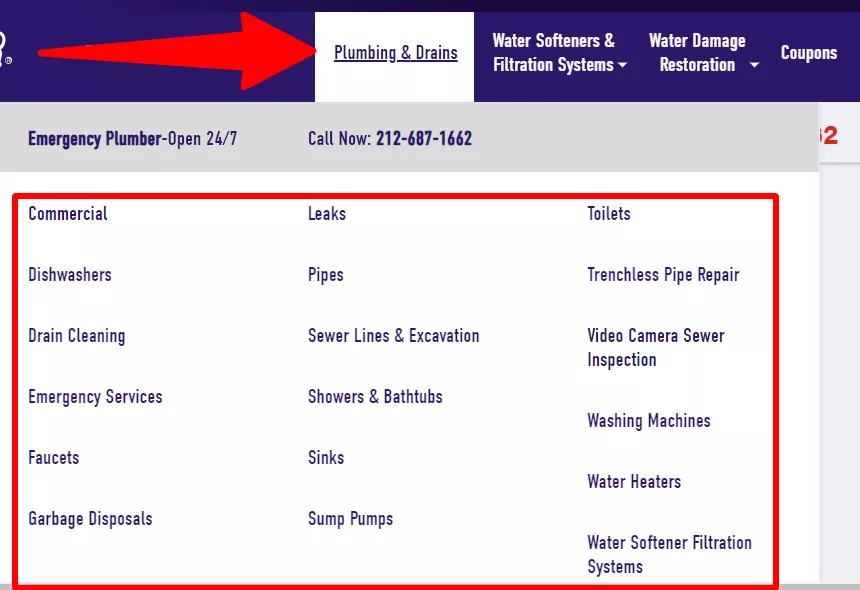
On each page, use the main service as your primary keyword and add relevant or secondary keywords by using the method mentioned earlier in the keyword research section.
Those keyword groups will make your writing process easy. That will also help you to optimize your content efficiently.
But do not forget to avoid keyword stuffing as it is totally against Google’s guidelines.
Keep each service page comprehensive where all the information is properly covered. It must have an understandable language that makes people feel that those services are right for them.
Properly mention what you do, what you offer, who you serve and why choose you.
To ensure quality and relevance, just ask yourself if your content is right for the customers and properly answer their queries or not.
About Us
Since Google gives more importance to E-E-A-T, it is important to have an “About Us” page on your plumbing website too.
You can mention several things here:
Story of your business
Your qualifications and experience level
Any certificates or accreditations you or your team have
What makes you different from your competitors
Show what others think about your business through reviews or testimonials
Total number of projects done, etc.
When you discuss all those things, you make Google understand that you are an authority in your field and have the required qualifications. It sets you apart from others who fail to meet Google’s E-E-A-T criteria.
Location Page
If your business operates at multiple locations, you need to add all those locations on a separate page for locations.

From there, you can add links pointing towards the dedicated pages of each location. You can optimize those pages for a particular area like “Plumber in Hudson”, “Plumbing services in Essex”, etc.
Contact Us
This page lets users contact you and see other relevant information. It must have various contact options that allow users to make an inquiry or book an appointment.
Blog
A blog page provides you with an extra opportunity to cover as many keywords as you want related to your niche. Once you’ve covered the main keywords on all the pages of your website, you can now take advantage of related business queries to cover in your blog.
For example, you may write on topics like “how to find reliable plumbing services in NYC” or “how much does it cost to open a drain”. There is no limit to the keywords you can cover through your blog.
Doing this and giving comprehensive coverage of a particular topic also helps you to establish your business as an authority.
When you add regular blog posts, it tells search engines and users that this site is active. This also helps in improving crawling and indexing frequency.
On-page SEO
Now that you have learned how to create pages for your website, your next step must be to optimize them.
There are a few things that you will do. Let’s see them one by one.
Write a Captivating Meta Title and Description
Do you know what a title tag is?
A title tag appears in the search results and tells search engines and users what your page is about.

There are a few things that you should keep in mind while writing your title tags:
Make use of “power words” like perfect, remarkable, etc. while writing your title tags.
Add your focus keyword in the title, especially at the beginning. This shows relevance to Google and other search engines.
Keep it 55 characters long to avoid cutting off letters or words.
Besides title tags, there are a few best practices to optimize the meta description of pages.
A meta description is a short summary of your page or post that appears just below the title tag.

According to SEOs, it isn't a direct ranking factor but may contribute to it indirectly by increasing CTR.
Google doesn't always choose the meta description set by you. It may choose one on its own that it thinks is more relevant.
However, keep those things in mind while writing meta descriptions:
Keep it under 150 characters.
Add your focus keyword.
Meet search intent.
Use simple language to make people understand the content of the page/post.
Use phrases like “Learn more”, “Read on”, etc. to encourage users to click on it.
Use Short & Descriptive URLs
While writing URLs, keep a few things in mind:
Add relevant or focus keywords in your post URL. But that does not mean you should make it lengthy. Because if it is too long, search engines will truncate it. Also, remove the stop words as they unnecessarily make the URLs long.
Make use of hyphens to separate different words in a URL.
Strictly avoid adding dates.
Keep them concise and descriptive.
Technical SEO
If you want to see good results for your website, remember to optimize the technical side of your website. That means getting things done right at the backend of your website.
Technical SEO has several aspects that you need to focus on:
Optimize Site Speed
This must be your priority to make your website load faster so users can get the information instantly regarding your business.
If a website loads too slowly, it frustrates the users and makes them leave your site immediately.
You may use various tools to check the speed of your website for both mobile and desktop versions.
Google PageSpeed Insights is the best tool that is free and also gives you insights into your website speed in a detailed manner.
If your website also loads slowly, it's time to optimize its speed.
You can do this by:
compressing images
uninstalling unused plugins
minifying JavaScript and CSS
enabling browser caching
Fix Broken Links
Broken links are links to pages that do not exist.
If those links exist on your website, you must update them with live pages. You must be thinking how do I locate them?
It's simple and easy. Use a site audit tool like Screaming Frog and it will highlight all broken links on your website.
Once you have this list, update the links. That will help Google crawl and index these pages.
Plan Website Structure
Site structure is another important aspect of technical SEO.
Though I am mentioning it here, planning a site structure must be at the top of your list before launching a website.
Your structure must be clean and easy to navigate both by search engines and users. Also, do not forget to add relevant links to other pages.
Here is a simple overview of a clean website architecture.
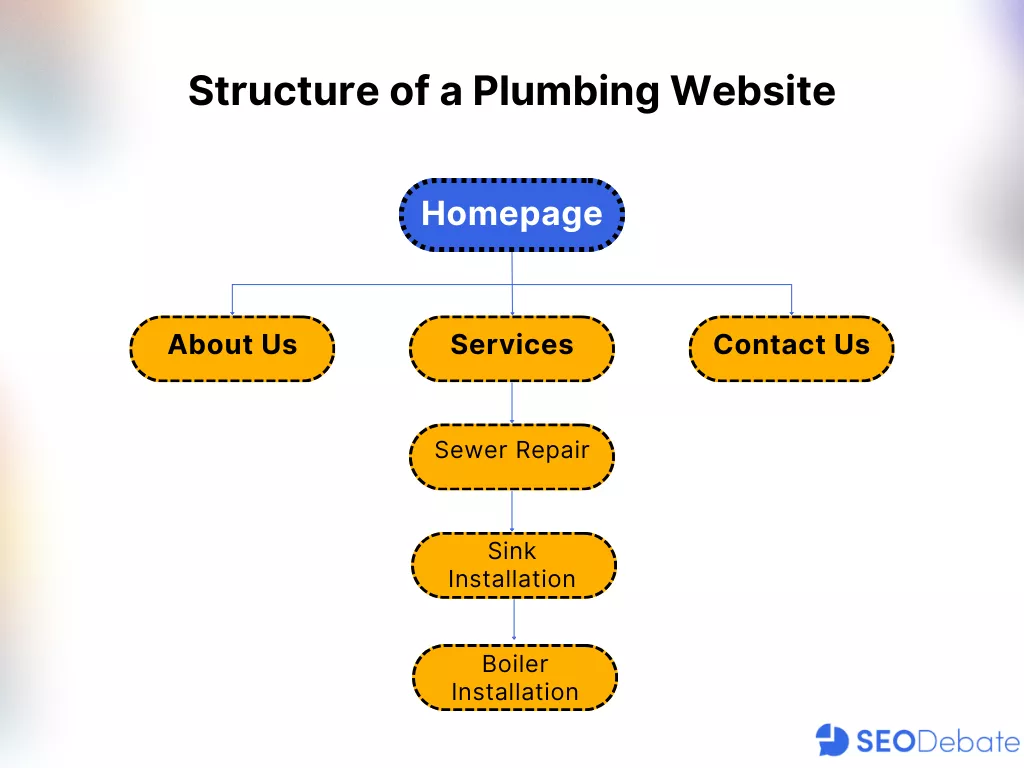
Recommended Reading: Know each and everything about website architecture in this detailed guide.
Monitor Site Health
Your rankings can be affected when there is an issue with your site's health. Sometimes a minor issue can have a big impact on your online presence, so knowing all this ahead of time is important.
Use a site health check tool and keep an eye on your Google Search Console account. It will tell you about any indexing issues that you can fix.
This is what your GSC account may look like.
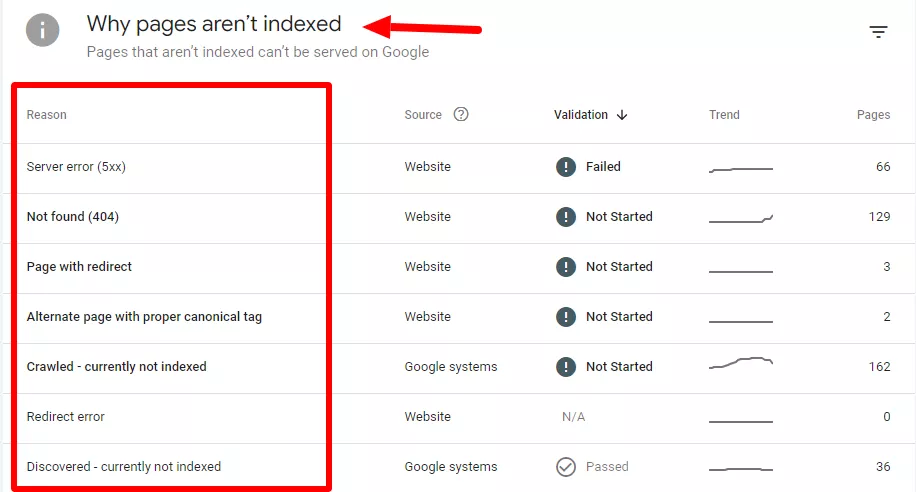
Other than GSC, site health check tools by Ahrefs and Semrush give you a more comprehensive overview of all the major SEO issues on your website. These tools are paid, but investing in them can be worthwhile.
Optimize Robots.txt and Sitemap
Help Google efficiently crawl and index your website by optimizing robots.txt file and website sitemap.
Robots.txt file is placed in the root directory of your website and it instructs the search engines which pages they are allowed to access and which they are not.
It ensures that only the intended pages are crawled by search engines.
FYI: For a deeper dive, check out our comprehensive article on robots.txt.
On the other hand, a sitemap is a file that lists all your site’s pages to help search engines easily find them.
You can create a sitemap manually or use various tools. Once you have created a sitemap, submit it through your GSC account which is recommended and easy. Learn more about understanding, creating and submitting XML sitemaps with this comprehensive guide.
Link Building
Link building is one of the strongest Google ranking factors.
When your website has several high-quality backlinks, it signals to Google that your website is an important source of information.
Keep in mind quality of links matters more than quantity. So you must focus on those that are relevant to your niche and come from high authority sites.
There are several methods of growing your backlink profile.
Earning Backlinks: One way is to earn backlinks by creating high-quality content. This makes other websites link to your content because of the value it provides.
Outreach Method: Another way is to approach the relevant industry experts or sites to link back to you. It includes several practices like guest posting, link exchange, HARO, press releases, etc.
Recommended Reading: I recommend you read my detailed guide on backlinks and link-building for a more comprehensive understanding.
What is Link Building & its Most Common Strategies
Content Marketing
Creating valuable content that other wants to link to must be part of your SEO campaign. Google favours content that is regularly added, updated and linked to.
This is how content marketing works. You create helpful content that your targeted audience is looking for.
This is a win-win for both as your customers get the helpful information or services and you get the revenue by converting them into customers.
So how would you do that for your plumbing business? You can do this by following these steps:
Choose a Topic
Finding topics that people are already searching for is the best way to start writing.
You can do this by using keyword research tools and applying the method I mentioned above. But for blog topics, it is good to target long-tail keywords or the “Questions” people are searching for.
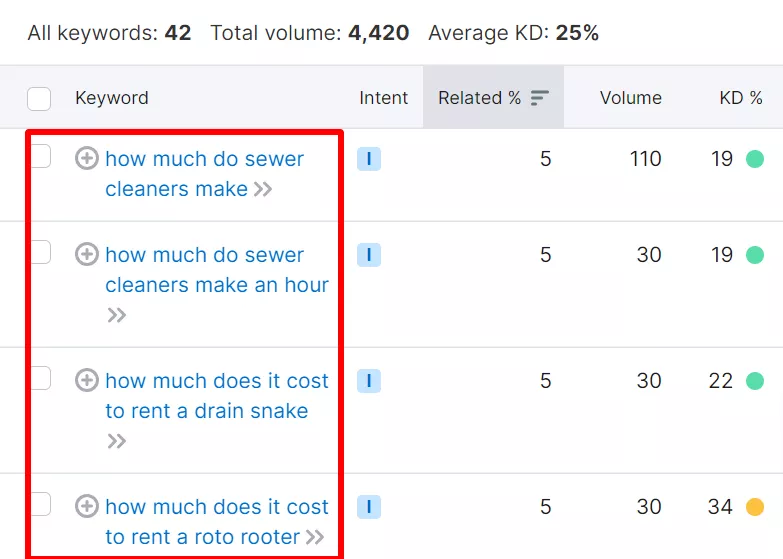
One valuable tip is to look for low-DA websites in your industry that have some decent traffic.
Now you can use a tool like Ahrefs or Semrush to see their top-performing pages or top organic keywords.
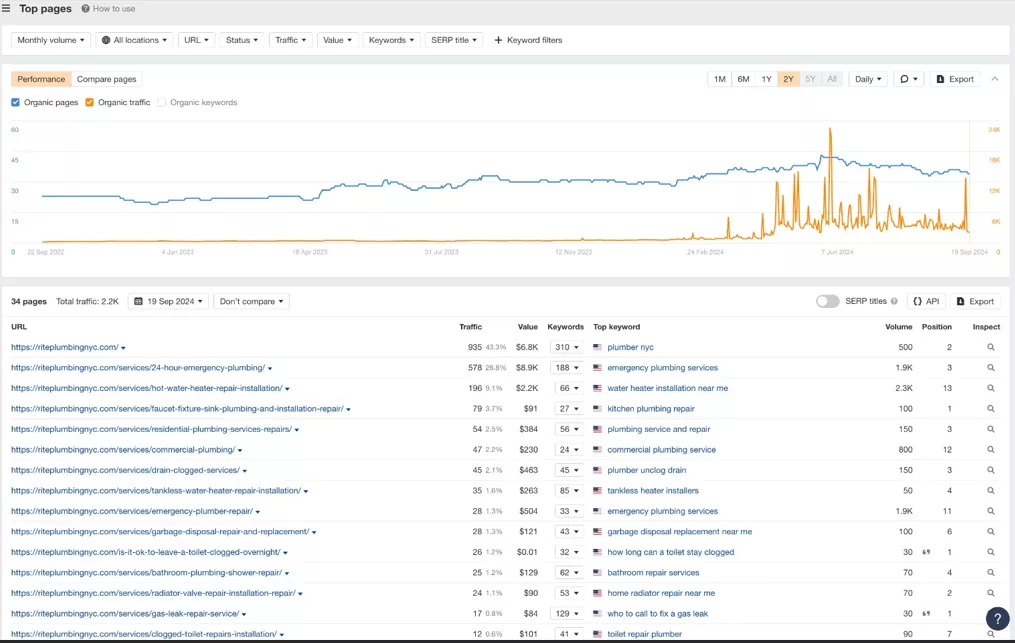
This will show you all the top pages that get most of the traffic for these websites. These pages are enough to get topic ideas for writing blog posts.
Optimize It
Getting keywords is half of the work you have done. The next half is to write content by using those keywords.
Keep these basic things in mind while writing your blog posts:
First, meet the search intent of people. For your keywords, look at SERP and see which types of pages are ranking there. If people want to read list articles, give them what they want. If they want comparisons or how-to blogs, write them.
Use a language that your targeted audience can easily understand.
Make your posts compelling by adding visual elements like images, videos, infographics and charts.
Write captivating titles and headings and keep URLs concise and descriptive.
Get Links to It
Getting links from relevant sources can be challenging especially if you have just launched your website. And without getting backlinks it is rare to rank your pages. It is that much important.
However, it is not impossible. You can do this by creating quality content that is better than anyone else. Now you need to search relevant websites in your industry and ask them to link to you.
One easy way to do this is by claiming the lost links. Almost all major SEO tools allow you to see the backlink profiles of your competitors and their lost backlinks. You can search for them and ask the websites that are pointing towards those lost pages to replace them with your live link.
The more quality and relevant backlinks your website has, the better your rankings will be in search ensign results pages.
Tracking Success
Once you are done with all your SEO efforts, now is the time to monitor your progress. You can do this by analyzing your Googe Business Profile, GSC and GA.
First, monitor the performance of your GBP by clicking “See profile performance”.

Secondly, you can track your progress by regularly monitoring your Google Search Console and Google Analytics account.
GSC gives you the list of keywords your website is ranking for along with your top-performing pages. Moreover, it also highlights the issues with your website, the total number of visitors over a specific period, average CTR, etc.
On the other hand, Google Analytics shows you how people find your website, the total number of visitors in real-time, the total time spent, page views, and plenty of other helpful information.
Keeping an eye on all these stats can help you track your progress, make adjustments, and improve your overall SEO strategy.
SEO Mistakes to Avoid
While planning and implementing SEO strategy, many SEOs make mistakes that ultimately lead them to give up on their websites. They usually:
Avoid doing enough keyword research
Do not meet the search intent
Target high-competition keywords just because they have a high search volume
Do not follow the search engine guidelines
Indulge in spammy tactics to instantly boost the rankings
Focus on building more backlinks rather than quality backlinks
Do not properly link the pages internally
Do not allow Google and other search engines to crawl and index the site
Have a poor user experience
Have a slow site speed
Neglect local SEO and its benefits
Expect the SEO results too soon
Besides that, there can be several other reasons that may avoid ranking your website.
If despite doing all efforts, your site isn't seeing any results, you may need to switch and try some other methods.
The first thing is to look into your SEO strategy. See what it lacks, identify the gaps, see the user response, or consult a professional.
An SEO professional will help you identify gaps in your SEO strategy.
Above all this make sure you have given enough time to implement a proper SEO plan. SEO takes time so instead of expecting the results too soon, focus on consistency.
The Final Words
When it comes to SEO for plumbers, you must stand out from the rest of the businesses. This includes adopting a combination of regular SEO practices along with local SEO.
Keep in mind that SEO isn't about getting higher rankings only. It is about building a reputation or authority in your industry to develop long-term connections with your clients.
A professional service provider or a good strategy considers all this. It does not only focus on increasing visibility but also stimulates long-term business growth.
SEO isn't a once-and-done task. You need to make a proper plan with the right execution to see the results. It takes time, but the results won't disappoint you.
FAQs on SEO for Plumbers
What is SEO for plumbers?
SEO for plumbers involves adopting practices to improve the visibility of plumbing websites. SEO makes websites appear higher in search results. As a result, it brings more traffic and more calls from customers.
Can I do plumbing SEO on my own?
Yes! You can do it. There are certain aspects of a website SEO that you can manage like writing content, doing keyword research, updating GBP, etc. However, if you are also responsible for performing other business tasks like attending calls or replying to customers’ mail, you may not be able to give proper attention to SEO which requires continuous efforts. So in that case, you can opt for an SEO agency or services.
Why do plumbers need SEO?
It is important as it helps make your business stand out from others. An SEO plan does not only identify the potential customers but also helps your clients understand why they should choose you. A proper SEO plan attracts more customers, retains the existing ones and establishes your brand as an authority in your industry.
How long does SEO for plumbers take?
Usually, it takes around 6-8 months to see the SEO results. You may start receiving calls or appointments instantly once you go live and publish content on a regular basis. However, typically your plumbing website may take time because SEO is a long-term strategy, not a short one like PPC.
What are the main components of a successful SEO strategy for plumbers?
To get more customers, a well-rounded SEO strategy is required. This includes covering all the aspects of a successful SEO campaign like keyword research, content creation, local SEO, GBP optimization, link building, social media promotion, reviews management, and technical optimization of a website.


